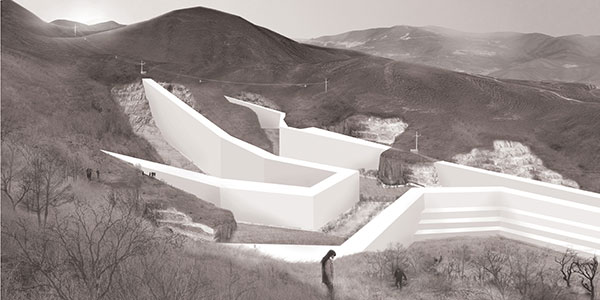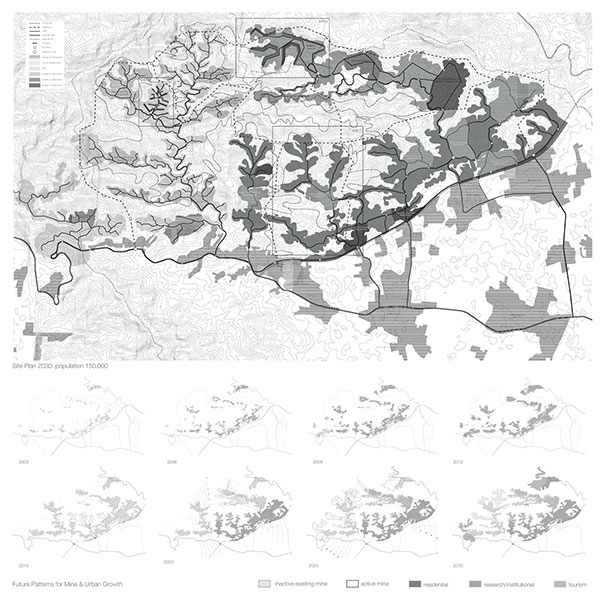Neo-Mining: Reconstituting the Foothills of Beijing for Peri-Urban Growth

by Emily Parish Gordon (MLA ’12) and Carmen Martínez Fernández-Barja (MAUD ’13)
Responding to the challenges of explosive growth in Beijing, and a site scarred by limestone mines, Neo-Mining proposes alternative processes for urban expansion. Accounting for the extraction and reconstitution of raw material as necessities of growth, Neo-Mining leverages these as drivers of urban form. An ecologic life-cycle approach to the reuse of mining sites and materials generates and informs a new model for foothill urbanization. The result is the planning of a visionary city; a unique urban identity carved from a phenomenal site.

Beijing is one of the fastest developing urban regions in the world. In the past 30 years, the city’s area has expanded by 700%, and the population has doubled to 17 million. Land and resource consumption continue to intensify with population. Large expanses of agricultural land are being consumed, contributing to the national food security crises. A recent government decree demands that the consumption of agricultural land cease, necessitating alternative solutions to meet the needs of exponential urbanization. With another doubling of population predicted by 2030, the Beijing region must house an additional 17 million urban residents. Working within a framework known as the “foothill strategy,” this project assumes an experimental approach to alternative urbanization tactics in the foothills surrounding Beijing.
The township of Qinglonghu spans the plane-foothill threshold southwest of Beijing, just off the 6th ring road. About 100 square kilometers holds 32 villages and 41,600 residents. The foothill strategy necessitates that Qinglonghu absorbs 100,000-300,000 residents by the year 2030. Pressing concerns include water shortages, agricultural preservation, brownfield remediation, and transportation restrictions as well as considerations for housing strategies, density, and urban program that fully respond to the unique conditions of the foothill site.
Over 12% of Qinlonghu is currently textured by open-pit limestone mines. Though mostly closed during the Beijing Olympic Games in 2008, the mines hold a dramatic physical and economic presence on the landscape. Because of their proximity to sites of urban expansion and the continued demand for material, the Neo-Mining proposal fundamentally questions the closure of the mines and the current costs and methods of remediation. Neo-Mining instead proposes alternative processes for urban expansion that account for the extraction and reconstitution of raw material as necessities of growth and potential drivers of urban form. An ecologic life-cycle approach to the reuse of mining sites and materials generates and informs the new foothill city.
Collapsing sites of extraction with sites of construction, Neo-Mining proposes continued mining phased with the construction of a new city directly on the Qinglonghu mines themselves. As a result, land disturbance is minimized and the agricultural plane is preserved. Mining techniques and technologies are altered to efficiently provide both the material source of the city and its constructed foundations as well. Methods that previously degraded the environment are altered to become the backbones of new urban ecologies. Developing beyond a master plan that details phasing, connectivity, urban program, and density distribution, three specific experiments in urbanization ensue. Factors explored include material re-use, water management, landscape strategies, urban program, built form, and ultimately, unique urban identities carved from phenomenal sites.
